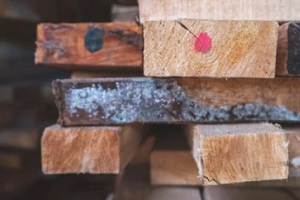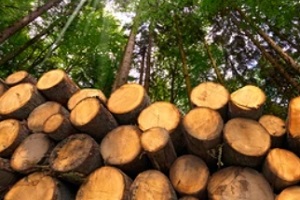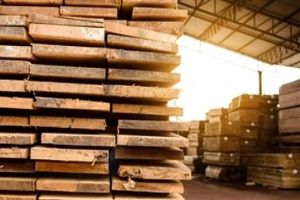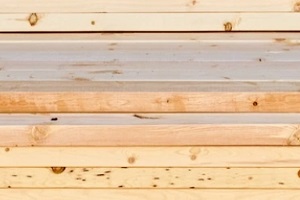 Lumber is a sawn and formed wood product made from harvested tree timbers. As wood does not grow with uniform consistency, it has faults that affect the overall look and structural properties of the lumber produced. In the United States, lumber is graded to establish a degree of reliability in the appearance and structural value of mills’ final products. Both hardwood and softwood lumber have grading systems. This article gives an overview of both systems as well as explains what each grade means.
Lumber is a sawn and formed wood product made from harvested tree timbers. As wood does not grow with uniform consistency, it has faults that affect the overall look and structural properties of the lumber produced. In the United States, lumber is graded to establish a degree of reliability in the appearance and structural value of mills’ final products. Both hardwood and softwood lumber have grading systems. This article gives an overview of both systems as well as explains what each grade means.
Hard vs. Soft Wood
Softwood and hardwood are two different types of wood. Those phrases, however, are not a precise indicator of the wood’s relative hardness. Softwoods are obtained from the harvest of coniferous trees, more commonly referred to as evergreen trees. These trees are distinguished by the presence of needles and cones rather than leaves.
Softwood trees grow at a faster rate than hardwood trees, producing timber that is lighter weight and less dense than hardwood timber. The rapid growth rate contributes to the plentiful supply, with softwoods accounting for the majority of processed timber. They have a straighter and smoother grain, making them ideal for framing and construction materials like windows and doors.
The following are some of the most regularly utilized softwoods for timber production:
- Southern Yellow Pine
- Red and Yellow Cedar
- Douglas Fir
- Redwood
- Pine
- Spruce
Hardwoods, on the other hand, are made up of angiosperms, flowering trees with broad leaves that shed their foliage in the fall and winter. These trees have vessels that act as water distribution mechanisms, as well as pores on their surfaces, which result in more detailed and intriguing grain patterns than softwoods.
 Hardwood trees develop at a slower rate than softwoods, contributing to their greater density, which makes them naturally more durable and stronger than softwoods. This feature makes them ideal for use in furniture, cabinets, flooring, and other building applications where durability is a priority.
Hardwood trees develop at a slower rate than softwoods, contributing to their greater density, which makes them naturally more durable and stronger than softwoods. This feature makes them ideal for use in furniture, cabinets, flooring, and other building applications where durability is a priority.
Slower growth rates and strong, ongoing demand makes hardwood lumber more costly than softwood. The more commonly used hardwoods are:
- Alder
- Cherry
- Ash
- Beech
- Hickory
- Birch
- Mahogany
- Oak
- Maple
- Poplar
- Walnut
- Teak
Lumber Grading
Under the authority of the U.S. Department of Commerce, the American Lumber Standard Committee created and maintains the American Softwood Lumber Standard PS 20. Construction lumber, which can be further classified into appearance, non-stress-graded, and stress-graded lumber, is the most common use case for softwood timber. The overall aesthetic quality of appearance timber is the primary criterion, whereas the structural integrity of stress-graded or non-stress-graded lumber is the primary criterion.
The Illustrated Guide to American Hardwood Lumber Grades, developed by the American Hardwood Export Council, provides the foundation for the grading scale, standardization, and specifications of the characteristics and defects associated with ten of the most common hardwoods in use. Given the importance of the overall look of hardwoods, aesthetics is the key criterion for determining the grade of hardwood lumber.
Hardwood grading for lumber takes into account the number and size of pieces (or cuts) that may be produced during the manufacturing process. As a result, the grading system relies on the measurable proportion of defect-free clear wood in each grade.
 The better grades of hardwood will yield a higher percent of acceptable material yield, whereas lower grades of hardwood will yield a continuously decreasing percent of usable material yield. As a result, the highest grades produce the longest and largest clear pieces for use, but lower or common grades need further cuts to gain clear pieces, which will be shorter or smaller as a result.
The better grades of hardwood will yield a higher percent of acceptable material yield, whereas lower grades of hardwood will yield a continuously decreasing percent of usable material yield. As a result, the highest grades produce the longest and largest clear pieces for use, but lower or common grades need further cuts to gain clear pieces, which will be shorter or smaller as a result.
FAS (Firsts and Seconds), FAS/1F (FAS-One-Face), and Sel (Seconds and Thirds) are the highest grades (Selects). These are ideal for long clear moldings, furniture, and other products that require lengthy, clear cuttings. Number 1 and Number 2 are common grades that can be used for kitchen cabinetry, plank and strip flooring, and furniture pieces. The difference in grade between the upper and lower grades indicates the yield. The common piece will have the same clarity as the upper grade, but it will be smaller in size when compared to the FAS and Select grades.
The first and second grades are divided into two groups (FAS)
First and second grade (FAS) must meet the following standards:
- a minimum board size of 6” x 8”
- a yield of 83-1/3% to 100% clear wood cuttings
- a length of 8’ or longer
- a minimum cutting size of 3” wide x 7’ long or 4” wide x 5’ long
The FAS One Face (F1F) grade requires the component to meet the FAS grade standards for the better face, while the poor face of the board can meet the lesser number 1 common grade requirements. When supplied in an agreed-upon percentage, such as 80 percent FAS/20 percent F1F, this grade is frequently blended with FAS.
Choosing A Grade
Selects have the same specifications as the F1F, with the exception that the minimum board size is reduced to 4″ and wider with lengths of 6′ or longer.
Number 1 Common Grade (No. 1C)
Kitchen cabinets and furniture items are made from the Number 1 Common grade, commonly known as cabinet grade. The number one common grade necessitates:
- a 3″ wide board as a minimum
- a minimum of 4′ in length
- 66-2/3 percent clean face yield, up to but not exceeding the FAS minimum yield of 83-1/3 percent 3″ x 3′ or 4″ x 2′ minimum clear-cutting size
- a requirement that both sides of the board meet these requirements
Number 2A Common Grade (No. 2C)
Number 2A Common grade, often known as Economy grade, cuts yields and board sizes even more. This grade is frequently chosen for usage in the hardwood flooring business, and it is also used in the production of tiny furniture components. The 2A Common grade necessitates:

- a 3″ wide board as a minimum
- a minimum of 4′ in length
- a clear face yield range of 50 percent minimum to 66-2/3 percent maximum, but less than the Number 1 Common yield limit
- 3″ x 2″ minimum clear-cutting size
The worst face will be used to determine the grade. Even if the better face received a higher grade, the item will still receive a 2A Common rating.
Contact The Lumber Experts At Curtis Lumber
At Curtis Lumber Lumber, we are a wholesale distributor of Southern Yellow Pine lumber and plywood. If you are a retailer and have any questions or concerns regarding lumber grades and which ones are best, please don’t hesitate to contact our team of professionals at Curtis Lumber and Plywood for more details and useful information!

